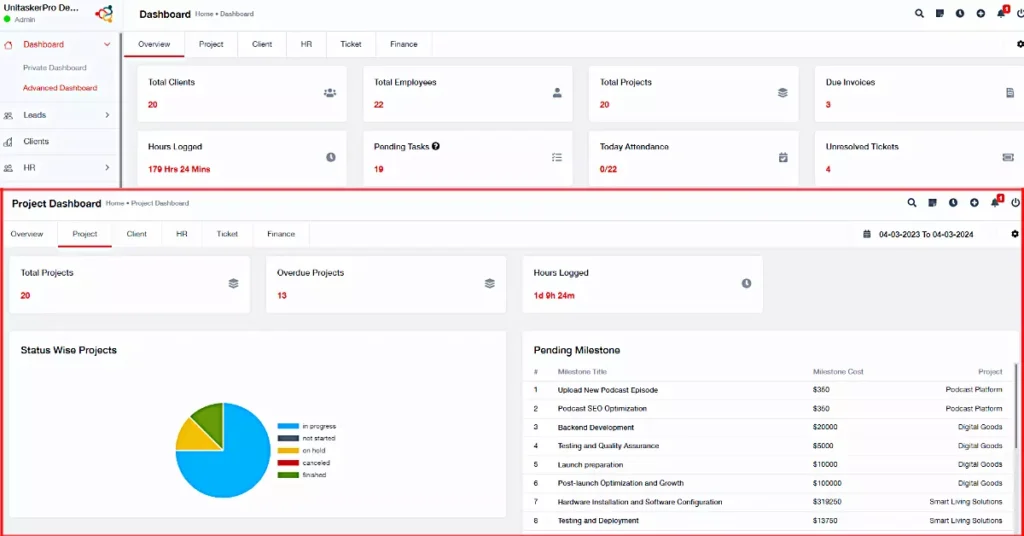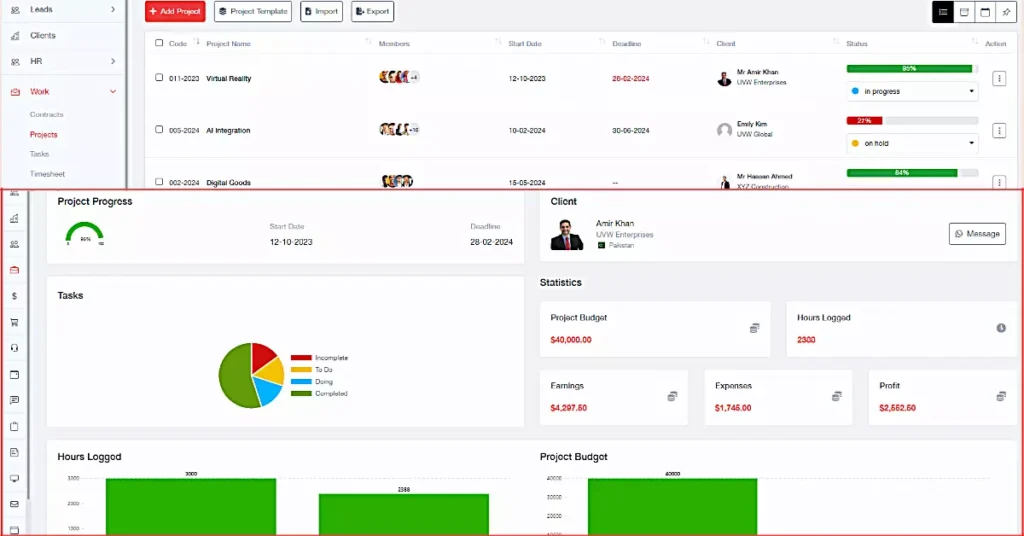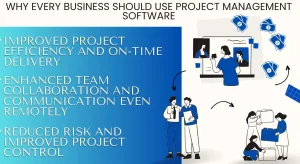In today’s fast-paced business world, effective use of project management software is essential for any team, from small groups to large organizations. Effective workload management involves smartly distributing tasks, aligning them with team members’ skills, and ensuring no one is overloaded. This approach leads to improved task allocation and prioritization, ultimately boosting productivity.
Understanding Workload Management Software
Workload management software is a tool used to optimize task distribution, progress monitoring, and resource management within a team or organization. Its evolution has been driven by the shift from manual, paper-based methods to digital tools, accommodating changes like remote work and complex project management.
Key aspects include:
- Balanced Task Distribution: Assigning tasks based on realistic estimations and deadlines to prevent overloading team members.
- Task Prioritization: Regularly organizing tasks to focus on what’s most important, ensuring efficient workflow.
- Resource Management: Utilizing tools like resource calendars for insight into team availability, helping to allocate tasks effectively.
- Communication and Check-ins: Maintaining open lines of communication for addressing issues and ensuring balanced workloads.
- Digital Tools: Leveraging workload management software for streamlined task organization and tracking.
- Training and Skill Development: Equipping team members with the skills to manage workloads effectively.
- Leading by Example: Encouraging healthy work habits to promote a positive and productive work environment.

Adopting these strategies results in a more productive, stress-free, and engaged team, steering your organization towards greater success.
The evolution of these tools has progressed from basic spreadsheets and project management software to comprehensive platforms, which offer a wide range of features for task scheduling, progress tracking, and collaboration. They also facilitate remote work and adapt to the digital transformation of workplaces.
Challenges in workload management include balancing team member workloads, adapting to changing priorities, and managing remote teams. Effective strategies involve setting clear objectives, prioritizing tasks, using workload management software for task assignment and monitoring, and maintaining effective communication within the team.
9 Best Workload Management Softwares:
Here’s a comprehensive overview of some of the top workload management software available in 2024, highlighting their unique features, pricing, usability, and how they cater to different business needs:
1. Unitasker Pro:
Unitasker Pro is a comprehensive business management solution designed to streamline various business processes. Here’s an overview of its features, pricing, usability, and how it caters to different business needs:
Unique Features:

- Intuitive Dashboard: Centralized view with real-time updates, customizable widgets, and quick navigation.
- User-Friendly Navigation: Clear menu structure, contextual sidebars, and responsive design.
- Interactive Task Management: Facilitates project collaboration and boosts productivity.
- Detailed Insights for Decision Making: Offers powerful analytics and reporting tools.
- Advanced Payroll Precision: Ensures accurate and efficient payroll processing.
- Dynamic Project Collaboration: Centralized platform for team collaboration.
- Functional HR Calendar: Manages employee schedules, leaves, and HR events.
- Advanced Recruitment System: Streamlines the entire recruitment lifecycle.
- Advanced Support Ticketing System: Centralized platform to manage and resolve customer issues.
- Intelligent Attendance System: Tracks employee attendance, leaves, and productivity.
Pricing:
Unitasker Pro offers three main plans & includes an exclusive 14 free trial. So that users can test the features and decide can themselves whether to go forward with.
- Basic Plan: At $24.99/month (or $20.82/month annually), ideal for small businesses, startups, and freelancers. Includes features like 20 users, a dashboard, user management, core HR, and timesheets with 5 GB of storage.
For more pricing details, you can visit the UniTaskerPro pricing page. You will be able to find more comprehensive details of the pricing and features of UniTaskerPro.
Usability:
Unitasker Pro is known for its user-friendly interface, making it accessible for users with varying technical expertise. Its design focuses on simplicity without compromising functionality, ensuring that all users can navigate the software effortlessly.

Catering to Different Business Needs:
Unitasker Pro is versatile and caters to a wide range of business needs. Its modular design allows small businesses to start with essential features and scale up as they grow. The software is ideal for various types of companies, including e-commerce, legal firms, advertising agencies, healthcare providers, educational institutions, and more. Its comprehensive set of features ensures that it can meet the diverse requirements of different industries.
Overall, Unitasker Pro provides a versatile and comprehensive solution for businesses looking to streamline their operations, enhance productivity, and manage various aspects of their organization efficiently.
For more detailed information about Unitasker Pro’s features and pricing.
2. Wrike:
Wrike is a comprehensive project management software tool that offers a variety of features catering to workload management, particularly suited for enterprise-level teams managing complex workloads and schedules. Below is a detailed description of its unique features, pricing, usability, and how it caters to different business needs:
Unique Features:
- Workload Charts: These provide a visual representation of individual and team workloads to aid in planning.
- Task Management: Allows tracking of task progress, setting deadlines, and assigning responsibilities from a unified dashboard.
- Work Schedules: Enables the creation of custom work schedules for the team.
- Workload View: Offers a comprehensive overview of the team’s workload, facilitating easy task reassignment through a drag-and-drop interface.
- Task Dependency Management: This feature enables mapping out task sequences and dependencies.
Pricing:
Wrike’s pricing is diverse, catering to different organizational needs:
- Free Plan: Offers centralized project scheduling.
- Team Plan: Priced at $9.80 per user per month, ideal for project visualization and planning.
- Business Plan: At $24.80 per user per month, it’s suitable for advanced project scheduling and resource management.
- Enterprise Plan: Custom pricing is provided for enterprise teams.
- Pinnacle Plan: It also offers custom pricing and is designed for enterprise teams with complex needs.
Usability:
Wrike is known for its user-friendly interface, which is intuitive and easy to navigate. This makes it accessible for users with various levels of technical proficiency. The platform’s versatility allows it to be used for a wide range of project management activities, from simple task tracking to complex project planning and reporting.
Catering to Different Business Needs:
Wrike is particularly effective for large organizations and enterprises due to its comprehensive set of features and scalability. It is well-suited for teams that require detailed project planning, resource management, and workflow customization. Wrike’s ability to integrate with other business tools makes it a versatile option for organizations that use a variety of software solutions.
3. Monday.com:
Monday.com is a popular project management and team collaboration software platform designed to streamline workflows and improve productivity for businesses of all sizes. It offers a range of unique features, pricing options, and customization capabilities to cater to various business needs.
Unique Features:
Customizable Workflows: Monday.com allows for custom board and workflow creation, catering to specific needs like project management, task tracking, CRM, and HR.
- Visual and Intuitive Interface: The platform uses a user-friendly drag-and-drop interface, reducing the learning curve and promoting widespread adoption.
- Automation: Monday.com offers automation features to streamline repetitive tasks with triggers, actions, and notifications.
- Integration: It integrates seamlessly with popular apps like Google Workspace, Microsoft 365, Trello, and Slack for enhanced versatility.
- Dashboards and Reporting: Users can create custom dashboards and generate reports to track progress, monitor KPIs, and make data-driven decisions.
- Collaboration Tools: Features like comments, file sharing, and @mentions facilitate communication among team members directly within tasks and projects.
- Time Tracking: Users can track time spent on tasks and projects, making it useful for businesses billing clients based on hours worked.
Pricing:
Monday.com offers several pricing plans to accommodate different business needs:
- Basic: Starts at $8 per user per month (billed annually). Includes basic features and templates.
- Standard: Starts at $10 per user per month (billed annually). Adds more features, automations, and integrations.
- Pro: Starts at $16 per user per month (billed annually). Offers advanced features like time tracking and reporting.
- Enterprise: Custom pricing. Suitable for larger organizations with specific requirements, offering advanced security and support options.
Usability:
Monday.com is known for its user-friendly interface, making it accessible to both tech-savvy and non-technical users. The visual nature of the platform simplifies task and project management, and the drag-and-drop functionality makes it easy to create and modify workflows. The availability of templates and a supportive community further enhances usability.
Catering to Different Business Needs:
Monday.com is a versatile platform catering to a wide range of business needs across industries. It excels in project management, enabling planning and tracking for projects of all sizes. Additionally, it offers customizable CRM boards for sales and customer relationship management, aids marketers in campaign planning and content calendar tracking, streamlines HR and recruitment processes, helps IT teams manage bug tracking and software development, assists finance departments with budgeting and financial reporting, and supports educational institutions in organizing curriculum planning, assignments, and administrative tasks. Its adaptability makes it a valuable tool for diverse business functions.
4. Jira:
Jira is a project and issue tracking software created by Atlassian, primarily used by software development and IT teams to manage projects, tasks, and workflows efficiently. Key highlights of Jira include:
Unique Features:
- Customization: Highly customizable to fit specific workflows and processes.
- Agile Support: Strong support for Agile methodologies like Scrum and Kanban.
- Integration: Seamless integration with Atlassian products and third-party tools.
- Advanced Reporting: Powerful reporting and analytics capabilities.
Pricing:
- The standard plan: Jira starts at an affordable rate of $7.75 per user per month, offering essential project management features.
- the premium plan : Starting at $15.25 per user per month, provides advanced functionalities and premium support, making it suitable for businesses with more complex project management needs and a higher level of support.
Usability:
Jira’s usability may vary based on the team’s familiarity with project management and Agile practices. While it offers extensive functionality and customization possibilities, new users might experience a learning curve. However, Atlassian provides comprehensive documentation and support resources to assist users in getting started and maximizing their use of the platform.
Catering to Different Business Needs:
Jira serves a broad spectrum of business needs, making it suitable for various industries and teams, including:
- Software development teams seeking Agile project management and issue tracking.
- IT teams managing support tickets, incidents, and changes effectively.
- Marketing and content teams handling campaign planning and content management.
- Product development teams managing feature requests and roadmaps efficiently.
5. ProofHub:
ProofHub is a versatile project management and team collaboration tool suitable for different business sizes and industries. Its features cater to needs in marketing, sales, operations, product development, and creative fields.
Unique Features:
ProofHub offers a suite of features that support project and resource management, collaboration, and reporting. Key features include:
- Project Reports: Allows monitoring of project and team performance, with insights into tasks completion and progress.
- Resource Reports: Offers a bird’s eye view of team performance and individual workload overview.
- Workload Reports: Helps in managing team’s workload by checking the distribution of tasks.
- Custom Reports: Enables creation of tailored reports for detailed insights on projects.
- Various Views: Includes different views like ‘Me View’, ‘Profile View’, and ‘My Tasks’ for personal and team activity tracking.
- Collaboration Tools: Mentioning, announcements, enhanced email preferences, and in-app notifications enhance team collaboration.
- Proofing Tool: Facilitates easy review and proofing of work.
Pricing:
ProofHub offers two pricing plans:
- Essential Plan: Priced at $45/month when billed annually (or $50/month for monthly billing), it allows up to 40 projects and unlimited users.
- Ultimate Control Plan: At $89/month with annual billing (or $99/month monthly), this plan allows unlimited projects and users. It includes additional features like API access, advanced activity logs, and priority support.
Notably, ProofHub has a flat-rate pricing model without any per-user charges, making it cost-effective for teams with a large number of users. It also provides a discount for non-profit organizations.
Usability:
Users have found ProofHub’s interface intuitive, with easy navigation between buttons, actions, and work views. The software includes built-in tutorials for features like Gantt charts and calendars. However, the user documentation is extensive, covering features such as chat, reports, time management, and work views.
Catering to Different Business Needs:
ProofHub is a tool that helps different types of businesses, like marketing, IT, or engineering teams, manage their work. It’s useful for both small and big groups, but especially good for big teams because they don’t charge extra for more people. The tool can be used on phones, making it easy to work from anywhere. It’s great for teams to talk and work together on big projects.
6. Trello:
Trello is a versatile project management tool that stands out for its simplicity, flexibility, and visual approach to task management. It’s designed to cater to a wide range of business needs, from small teams to large enterprises.
Unique Features:
- Visual Organizing Tools: Trello’s interface is centered around boards, lists, and cards, which allows for easy organization and tracking of tasks.
- Drag-and-Drop: This feature simplifies task prioritization and management.
- Templates: Trello offers various templates to customize boards according to specific project needs.
- Communication Features: It includes tools for live chat, discussions, and general announcements.
- File Sharing and Notes: Users can easily share documents and notes within the platform.
- Project Tracking: Trello visualizes work progress and helps in monitoring task completion stages.
- Scheduling: The calendar view aids in transparent task allocation and monitoring.
- Offline Mode: Allows users to work offline with automatic syncing when back online.
Pricing:
- Free Plan: Offers basic features like unlimited cards, up to 10 boards per workspace, and basic integrations.
- Standard Plan: Priced at $5 per user/month (if billed annually), adding unlimited boards, advanced checklists, and custom fields.
- Premium Plan: At $10 per user/month (annually), this includes additional views like Calendar, Timeline, and Dashboard, along with advanced admin and security features.
- Enterprise Plan: Costs $17.50 per user/month (annually), catering to larger organizations with additional security and administrative controls.
Usability:
Trello is known for its user-friendly interface, making it easy for teams to adopt and use. It provides a clear visual representation of tasks and projects, enhancing team collaboration and communication. However, it might lack some advanced features found in more complex project management tools, like built-in time tracking and detailed reporting.
Catering to Different Business Needs:
Trello is a versatile tool that meets various business needs through its task management capabilities, making it effective for assigning and tracking project progress. It’s particularly useful for managing content calendars, aiding in the planning and monitoring of content creation. For project roadmaps, Trello is helpful in outlining tasks, setting objectives, and keeping track of milestones. It also enhances team collaboration, especially beneficial for remote teams. The platform’s flexibility, underlined by its simple core features and the capacity to integrate with numerous third-party apps and plugins, allows it to adapt to diverse workflows and processes.
7. Asana:
Asana, a prominent project management tool, offers a range of features, pricing plans, and usability aspects tailored to various business needs. Here’s a more detailed overview:
Unique Features :
- Automated Workflows: Helps in creating efficient processes for managing projects across departments, reducing the time spent on manual coordination.
- Goal Alignment: Connects tasks and projects to the larger company goals, enhancing focus and accelerating decision-making with real-time data.
- Resource Management: Provides tools for planning timelines, adjusting workloads, and tracking progress towards objectives.
- Enterprise Security: Offers robust security and governance for large-scale deployment across organizations.
- AI Integration: Asana has incorporated AI to enhance clarity and efficiency at various organizational levels.
- Broad Integrations: Compatible with numerous other tools like Microsoft 365, Google Workspace, Slack, and Salesforce, facilitating a connected work environment.
Pricing Plans:
- Personal Plan: Free of charge, ideal for small teams or individual use, with basic project management features and limited file storage.
- Starter Plan: Includes advanced features such as timeline views, enhanced search, and more collaboration options. It’s priced per user and is suitable for growing teams.
- Advanced Plan: Offers additional tools for portfolio management, goals, and workload, targeting larger teams and departments.
- Enterprise Plans: Tailored for large organizations requiring extensive customization, advanced security, and administrative controls. This plan has special features like custom branding and priority support.
- Enterprise+ Plan: Aimed at organizations with stringent compliance and security requirements, offering features like audit logs, data loss prevention, and eDiscovery support.
Usability:
Asana’s interface is user-friendly and intuitive, although it might require some initial adjustment for first-time users. It’s accessible via web and mobile applications, ensuring flexibility and convenience for users.
Catering to Different Business Needs:
Asana’s range of plans from free to enterprise-level caters to businesses of all sizes, scaling as the business grows. The billing system is flexible, allowing organizations to choose who is covered by the paid plan and offers plans for teams, divisions, and entire organizations. Asana provides guest access for external collaborators, not counting them towards the billing seat limit, which is beneficial for teams working with vendors or clients. It adapts to different organizational structures, supporting entities like teams, divisions, and separate workspaces.
8. ClickUp:
ClickUp is a comprehensive project management tool known for its versatility and rich feature set, catering to various business needs across different departments like project management, marketing, sales, and more.
Unique Features:
- Agile Project Management: ClickUp includes an Agile project management template, beneficial for teams adopting Agile methodologies.
- Multiple Views: Over 15 different views are available, including List, Board, Calendar, Gantt, and more, offering flexibility in how tasks and projects are visualized and managed.
- Customization without Code: The platform allows extensive customization without the need for coding or add-ons. This includes hundreds of templates and the ability to personalize task and document relationships.
- Collaboration Tools: Features for collaboration are robust, including chat, real-time visual whiteboards, task commenting, design proofing and annotation, and in-app email functionality.
- Real-Time Reporting: Goals and progress can be tracked effectively with real-time reporting tools, including dashboards with visual widgets, workload views, and goal-setting features.
Pricing:
ClickUp offers several pricing tiers, starting with a basic free option to more advanced plans for larger enterprises.
- Free Plan: Includes basic features like 100MB storage, unlimited tasks, and collaborative tools.
- Paid Plans: The paid tiers offer additional features like unlimited storage, advanced time tracking, and custom exporting, with prices ranging from $7/user/month to enterprise-level pricing.
Usability:
ClickUp is known for its user-friendly interface but also has a bit of a learning curve due to its high customizability and numerous features. The platform offers onboarding resources like webinars, user documentation, and ClickUp University to help users get acclimated.
Catering to Different Business Needs:
ClickUp’s scalable and customizable nature makes it suitable for businesses of all sizes. The tool’s flexibility and integration capabilities (over 1,000 tools) ensure that it can be tailored to fit specific workflows and requirements of various industries.
9. Teamwork
Teamwork is a comprehensive project management and client work platform that stands out for its versatility, catering to a wide range of business needs. Here’s a brief overview focusing on its unique features, pricing, usability, and suitability for different business types:
Unique Features:
- Client Operations and Project Management: Teamwork.com offers a blend of client operations control and robust project management, making it an all-in-one platform for managing all aspects of client work.
- Customizability: The platform allows customization of rates for team members or projects, ensuring accurate client billing.
- Resource and Time Management: Features like resource scheduler, personal timesheet, billable & user rates, and project budgeting tools are particularly beneficial for detailed project and resource management.
- Client and Project Overview: Tools for retainer management, expenses tracking, proofs management, and comprehensive project management tools like tasks & subtasks, custom fields, and milestones provide an extensive overview and control over projects.
- Integration and Automation: Teamwork.com integrates with popular tools like HubSpot, QuickBooks, and Slack, and offers extensive automation capabilities to streamline workflows.
Pricing:
Teamwork offers several pricing tiers: Free, Starter ($5.99/user/month), Deliver ($9.99/user/month), Grow ($19.99/user/month), and Scale (custom pricing).
- Free Plan: Ideal for small teams and freelancers, offering basic functionalities.
- Paid Plans: Progressively offer more features like advanced budgeting, powerful reports, unlimited custom reports, and resource scheduling.
- Enterprise Solution: The Scale plan is tailored for larger businesses with specific needs and offers extensive customizability.
Usability:
Despite its range of features, Teamwork.com maintains an intuitive and user-friendly interface. It’s suitable for various teams, including marketing, agencies, consultancies, product teams, software development, and creative teams. Being cloud-based, it facilitates remote and hybrid work environments, a crucial aspect of modern workspaces.
The platform’s ability to bring on free client users, track KPIs, manage sales funnels, and integrate with tools like Google Drive makes it ideal for marketing teams. Organizations benefit from its organizational, resource management, and profitability tracking features. Teamwork.com is particularly effective for client-focused teams, including professional services, business development, and creative teams, offering them comprehensive project and client management tools.
These tools offer a range of features and pricing options to cater to different business needs, from small teams to large enterprises. When choosing a workload management software, consider your team’s size, the complexity of projects, and specific features that are most important to your workflow.
Benefits of Implementing Workload Management Software
Implementing workload management software offers a multitude of benefits that can significantly enhance both project visibility and team collaboration, ultimately leading to more efficient time management. Here’s a comprehensive analysis based on top content found on Google:
Enhanced Project Visibility: Workload management software provides a clear overview of each team member’s responsibilities, enabling managers to identify bottlenecks or inefficiencies quickly. This leads to greater accountability and ensures that tasks are completed efficiently and effectively, as seen in professional services firms.
Improved Team Collaboration: By distributing tasks fairly and evenly among team members, workload management software promotes collaboration, minimizes potential errors, and ensures optimal resource utilization. Tools like Kanban boards facilitate this by visualizing workflow and setting up feedback loops to experiment with changes.
Efficient Time Management: Time-tracking features in workload management software provide insights into productivity levels and help identify challenges in task execution. This enables a more balanced distribution of work, preventing overloading of team members and allowing for prioritization of tasks.
Balancing Workloads: The software helps in balancing workloads by considering factors like the size of the team, the complexity of tasks, and the individual skills and availability of team members. This thoughtful task allocation not only maximizes productivity but also enhances job satisfaction.
Regular Monitoring and Adjustments: Regular check-ins and progress monitoring are key features of workload management software. They allow for proactive problem-solving and ensure projects stay on track. Adjustments can be made in real-time to address any emerging challenges.
Customization and Flexibility: The ability to customize and adapt workload management plans according to specific project requirements and team capacities is a significant advantage. This includes setting achievable deadlines and visualizing progress through various tools such as Gantt charts or to-do lists.
Resource Optimization: Efficient workload management leads to better utilization of resources, including human resources. By maximizing the capabilities of workload management software, organizations can forecast resource requirements more effectively.
Reducing Administrative Burdens: The software can help reduce time-consuming administrative tasks, freeing up employees’ time for more impactful work. This can lead to improved work quality and overall organizational efficiency.
Incorporating case studies or testimonials can further demonstrate these benefits in real-world applications. For instance, professional service firms that have implemented workload management software have seen significant improvements in project visibility, team collaboration, and time management, which in turn has led to higher productivity and client satisfaction.
Overall, workload management software is an invaluable tool for optimizing team performance, enhancing project management, and achieving a balance between workload and resources.
Choosing the Right Workload Management Software
When selecting workload management software, prioritize scalability to ensure it grows with your business, adapting to increasing demands. User-friendliness is crucial; an intuitive interface encourages quick adoption and minimizes training requirements. Integration capabilities are essential – the software should seamlessly blend with your existing systems for efficient workflow. Look for tools that provide real-time data syncing and support various devices for accessibility. Consider software that offers customization to align with your specific business processes. Avoid focusing solely on popular options; instead, assess each tool’s fit for your unique business needs. Opt for a trial run before committing, ensuring the software effectively enhances productivity and aligns with your business goals.
Implementation and Best Practices
To use workload management software well, start by understanding all the projects your team has. Break these projects into smaller tasks. Set clear goals for what you want to achieve. Assign tasks carefully, choosing the most important ones first. Make sure you have the right people working on the right tasks. Talk to your team often to see if they need to change their workload. Use tools like Kanban and calendars to keep track of everyone’s tasks. Give your team enough time to rest and make sure they’re not overworked. Avoid controlling every small detail. Offer training if needed. Be ready to make changes when necessary and keep everyone’s roles clear. Use templates for tasks that repeat to save time.
To wrap it up, workload management software is really important for making your business run better. These tools help in planning work, using resources well, and finishing projects on time. They make work flow smoothly, help teams work together better, and let you keep track of everything. This reduces stress and makes your team work better. It’s a good idea to check out these software options and think about how they can make things better for your business. Using this software helps your team work in a more organized and effective way.



